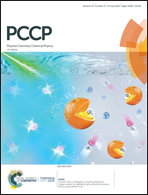Molecular aggregation in liquid acetic acid: insight from molecular dynamics/quantum mechanics modelling of structural and NMR properties
Abstract
The 1H NMR signal of the acidic proton in acetic acid molecules shows a marked upfield shift in the neat liquid as compared to that in low-concentration acetic acid solution in inert solvents where acetic acid cyclic dimers predominate. The underlying reasons for this phenomenon are analyzed in this work by considering classical molecular dynamics simulations and combined quantum mechanics/molecular mechanics calculations of the 1H NMR chemical shift of the acidic proton in the neat liquid and in the cyclic dimer of acetic acid in cyclohexane solution. Recorded trajectories were quantitatively analyzed in terms of different types of molecular aggregates formed in the neat liquid by using a geometrical definition of the hydrogen bond. Both the geometrical analysis and the computational NMR results indicate that the cyclic dimer cannot be the dominating aggregation pattern for acetic acid molecules in the neat liquid. The applied computational approach reproduces the lowering of the 1H NMR chemical shift of the acidic proton in acetic acid when going from cyclohexane solution to the neat liquid very well. The presence of acetic acid aggregates with hydrogen bonding between hydroxyl moieties and of monomeric acetic acid molecules in the neat liquid is found to lead to the observed lowering of the chemical shift, with lesser contribution from the formation of open acetic acid aggregates.



 Please wait while we load your content...
Please wait while we load your content...